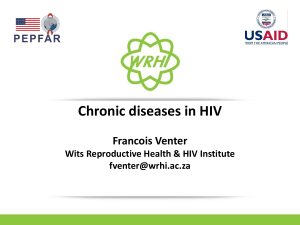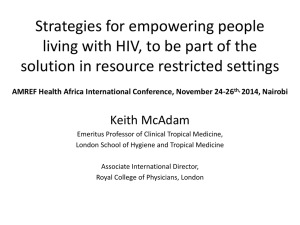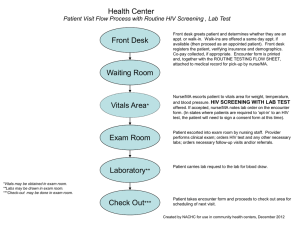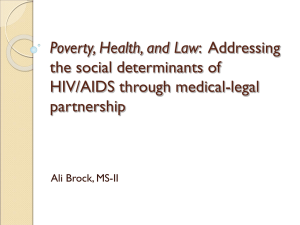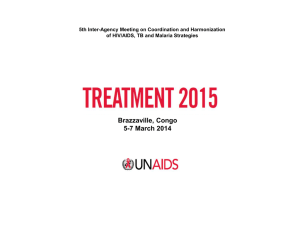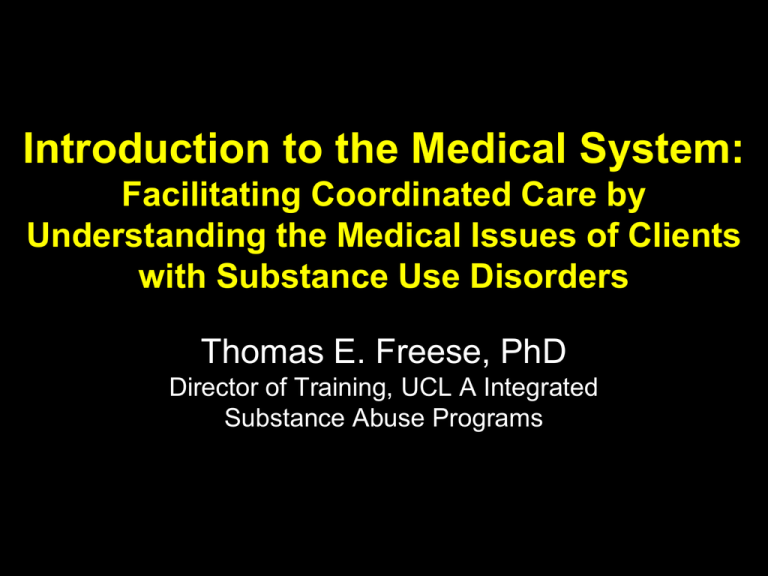
Introduction to the Medical System:
Facilitating Coordinated Care by
Understanding the Medical Issues of Clients
with Substance Use Disorders
Thomas E. Freese, PhD
Director of Training, UCL A Integrated
Substance Abuse Programs
Overview
• The medical system and managed care
• Factors for successful collaboration
• Common medical issues in substance
using clients
• Models of integration from real-world
settings
• Discussion
Per capita health care spending
Source: Organization for Economic Co-operation and Development. OECD Health Data
2006, from the OECD Internet subscription database updated October 10, 2006. Copyright
OECD 2006, http://www.oecd.org/health/healthdata.
We’re planning on
filling in the details
later
???
What is “Primary Care Integration”?
• Primary care integration is the collaboration
between SUD service providers and primary
care providers (e.g., FQHC’s, CHC’s)
• Collaboration can take many forms along a
continuum*
MINIMAL
Coordinated
BASIC
BASIC
CLOSE
CLOSE
At a Distance
On-Site
Partly Integrt
Fully Integrt
Co-located
*Source: Collins C, Hewson D, Munger R, Wade T. Evolving Models of Behavioral
Health Integration in Primary Care. New York: Millbank Memorial Fund; 2010.
Integrated
Minimal Coordination
The Primary
Care System
• BH and PC providers
– work in separate facilities,
– have separate systems, and
– communicate sporadically.
SUD
Care
System
MH
Care
System
Basic AT A DISTANCE
The Primary
Care System
• BH And PC providers
– Engage in regular communication
about shared patients leading to
improved coordination
SUD
Care
System
MH
Care
System
Basic On Site (co-location of services)
The Primary
Care System
SUD
SBI
Care
Counseling
System
Counseling
• BHand PC providers
– Still have separate systems
– Some services are co-located
(e.g., screening, groups, etc).
MH
Care
MH Services
System
Basic On Site (reverse co-location)
Referral
The Primary
Care System
SUD
Care
System
Medical
Services
• BH and PC providers
– Still have separate systems
– Primary care services are
integrated into BH Settings
MH
Care
System
Integrated
Integrated
The Primary
Care
Care
System
System
SUD
Care
System
MAT
• PC providers
– Develop and provide their won
services
MH
Care
System
Integrated
Integrated
The Primary
Care
Care
System
System
• BH and PC providers
– share the same facility
– have systems in common (e.g.,
financing, documentation
– regular face-to-face communication
SUD
Care
System
MH
Care
System
The Medical System
• Managed Care
– Any system that manages healthcare delivery
with the aim of controlling costs.
– Typically a primary care physician acts as
gatekeeper for other health services such as
specialty medical care, surgery, or physical
therapy.
– www.medicinenet.com
Managed and Fee-for-Service Care
Managed Care
Traditional Insurance
Choosing a
physician
Selected from plan list
Any
Specialty care
Primary care referral
Any
Quality of Care
Insurer determines prior to
enrolling the provider
Patient responsible for determining
Payment for
Services
Capitation
Individual pays fee for service.
Gets (partial) reimbursement
Advantages
Overall cost savings
Maximum flexibility
Disadvantages
Too few services provided
High cost
http://extension.missouri.edu/hes/infosheets/
The Medical System
Primary Care
• The aims of primary care are to provide
broad spectrum of care
– both preventive and curative;
– over a period of time; and
– to coordinate all of the care the patient
receives.
• All family physicians and most pediatricians
and internists are in primary care.
– www.medicinenet.com
The Medical System
Primary Care
• Practitioner must possess a wide breadth of
knowledge in many areas.
• Patients consult the same primary care doctor for
routine check-ups, and initial consultation about a
new complaint.
• Common chronic illnesses, often treated in
primary care, include:
– Hypertension
– Asthma and COPD
– Arthritis and other pain
-- Diabetes
-- Depression and anxiety
Strategies for successful
communication
• It is important to understand the system
with which you are working
• Learn about the medical conditions that
bring people to primary care
• Expand your vocabulary to facilitate
communication
• Stay within your scope of practice in your
interactions
• Make yourself visible and useful
Common Medical Issues
Associated with
Substance Use Disorders
Hypertension
Hypertension: Clinical Description
• Blood pressure (BP) is the
force against the walls of
one’s arteries while blood is
pumping.
• Hypertension is when BP is
too high.
• Example BP: 120/80 mmHg
(“120 over 80”)
– Systolic (top number):
pressure while heart contracts.
• Normal is <120. High is >180.
– Diastolic (bottom number)
pressure while heart relaxes &
enlarges.
• Normal is <80. High is >80.
Consequences of
Hypertension (HTN)
• Increased risk of:
– Stroke
– Blood vessel damage
(arteriosclerosis)
– Heart attack
– Tearing of heart’s inner
wall (aortic dissection)
– Vision loss
– Brian damage
(NIH, 2010)
Blood Pressure Link to SUD
• Three or more drinks per day increases BP &
risk of hypertension in both women and men
(Sesso, 2008).
• Decreasing alcohol consumption associated with
dose-dependent reduction in BP (Xin, 2001).
• Stimulants like cocaine or amphetamines can
cause HTN and other acute and chronic
cardiovascular diseases. (McMahon, 2010).
• HTN risk associated with quantity of cigarettes
smoked daily and the duration of smoking (Orth,
2004).
– Former smokers have higher rates of hypertension
than those who never smoked (Orth, 2004).
Hypertension & Your Clients
• HTN can be well controlled in primary care for
most patients (Williams 2004).
– Some many need help finding transportation.
– Some may need help finding free or low-cost clinics.
• Ask about alcohol consumption. Encourage
limiting to 2 or less drinks per day.
• If client smokes, give advice and support to quit
smoking (NICE, 2006).
• Encourage weight loss and salt reduction.
– Losing 10kg (22 lbs) can reduce systolic BP by 10
points (Cappuccio, 2007).
Common Medical Issues
Associated with
Substance Use Disorders
Endocarditis
Endocarditis: Basic Description
• Endocarditis is
inflammation of the
inside lining of the heart
chambers and heart
valves (endocardium)
• Usually caused by
bacterial infection but
can also be fungal.
http://www.nlm.nih.gov/medlineplus/ency/images/ency/f
ullsize/18142.jpg
(NIH, 2010)
Risk factors
Injection drug use increase risk:
• Particulate matter in injected drugs
• Poor injection hygiene (e.g., not cleaning skin
before injecting)
• Using unsterile equipment.
• Contaminated drug solutions.
• Physiological responses to certain drugs.
– E.g., cocaine causes blood vessels to constrict
(vasospasm) and damages cardiac tissue.
– Many studies shows speedball (heroin and cocaine
together) injection is a significant risk factor of bacterial
infections (Phillips, 2010).
Signs & Symptoms
• Symptoms can develop slowly
(subacute) or suddenly (acute).
– Common
• Chills
• Excessive sweating
• Fever
– Abnormal urine color
(bloody or dark)
– Fatigue/weakness
– Red, painless skin spots on the palms and soles
(Janeway lesions)
– Red, painful nodes in the pads of the fingers and toes
(Osler's nodes)
– Joint pain, muscle aches and pains
– Nail abnormalities (splinter hemorrhages under the nails)
– Swelling of feet, legs, abdomen
Endocarditis & Your Clients
• Clinical manifestations in injection drug users:
– 2/3 of patients do not display evidence of underlying
heart disease.
– Only 35% of IDUs demonstrate heart murmurs on
admission (Baddour, 2005).
• Treatment is intensive but largely successful.
– Most patients need to be hospitalized.
– Cure rates are high (85%) for right-sided endocarditis.
– Treatment cures infection relatively quickly (about 4
weeks).
• Severe cases exhibiting heart valve damage,
stroke, or heart failure may require valve
replacement
(NIH, 2010)
Common Medical Issues
Associated with
Substance Use Disorders
Chronic Obstructive Pulminary
Disease (COPD)
COPD Overview
(Chronic Obstructive Pulmonary Disease)
• Progressive disease that makes
it hard to breathe
• Cigarette smoking is the leading
cause of COPD
• COPD includes 2 main conditions:
• Emphysema: walls between air sacs
are damaged decreasing the amount of gas in the lungs
• Chronic Bronchitis: lining of the airways is constantly
irritated and inflamed causing the lining to thicken. Thick
mucus forms in the airways, making it hard to breathe
Signs & Symptoms
Signs of Emphysema
• Shortness of breath, especially during physical activities
• Wheezing
• Chest tightness
Signs of chronic bronchitis include
• Having to clear your throat first thing in the morning,
especially if you smoke
• A chronic cough that produces yellowish sputum
• Shortness of breath in the later stages
• Frequent respiratory infections
COPD Link to SUD
• Build-up of fluid in the lungs (acute pulmonary edema)
has been reported due to use of inhaled crack cocaine
and methamphetamines (Wesselius, 1997).
• Emphysema has been shown to develop secondary to
IV drug use (Wesselius, 1997).
• Individuals are 3 times more likely to develop COPD
when tobacco is used in conjunction with marijuana but
studies are limited and evidence is inconclusive
(ScienceDaily, 2009).
COPD & Your Clients
• Treatment depends on severity and general medical
condition. It is usually managed in a primary care
setting.
• Encourage your clients to stop smoking and using
drugs. Provide them with smoking cessation and
drug counseling options.
• Encourage compliance with medications , home
oxygen therapy, and pulmonary rehabilitation
(MayoClinic, 2010).
Common Medical Issues
Associated with
Substance Use Disorders
Diabetes
Type 2 Diabetes Overview
Basic Overview:
– Metabolic disease.
– Hyperglycemia (too much sugar)
due to insulin resistance and
defects in insulin secretion.
– Diabetes can lead to:
• blindness
• heart & blood vessel disease
• stroke
• kidney failure
• amputations
• nerve damage.
http://safediabetes.blogspot.com/2010/1
2/how-to-reduce-impact-type-2diabete.html
Type 2 Diabetes
Relationship with SUD
– Heavy alcohol consumption can increase risk factors
including: body-mass index, low HDL (“good”)
cholesterol and cigarette smoking (Tsumura, 1999).
– A history of substance use is associated with earlier
age of onset of diabetes (Johnson, 2001).
– SUD is associated with increased mortality in diabetics
(Jackson, 2007).
Societal Significance
– In 2006, it was the seventh leading cause of death,
although likely underestimated (National Diabetes
Statistics, 2007).
– In 2007, diabetes cost the US $174 billion in medical
costs, loss of productivity, disability costs (American
Diabetes Association, 2007).
Sign & Symptoms
• Often no symptoms at all.
• Most common symptoms
include:
– Blurred vision
– Erectile dysfunction
– Fatigue
– Frequent or slowhealing infections
– Increased appetite
– Increased thirst
– Increased urination
http://www.thetype2diabetesdiet.com/wpcontent/uploads/2009/03/symptoms-fortype-2-diabetes.gif
Type 2 Diabetes & Your Clients
• Medical services available on-site better link clients
in SUD treatment to medical services compared to
those with outside referrals (Friedmann, 1999).
• Social support for abstinence can increase linkage
to medical services. (Saitz, 2004).
• Encourage activities that improve diabetes:
– Better diet.
– Reduce simple carbohydrate intake (i.e. potatoes,
white bread, corn, soda, candy, sweets).
– More exercise.
– Maintain regular appointments with doctor overseeing
diabetes treatment.
Importance of Hemoglobin A1c Test (HbA1c)
• The hemoglobin A1c test is used to determine
how diabetes is being controlled.
• HbA1c provides an average of your blood sugar
control over a six to 12 week period.
• When blood sugar is too high, sugar builds up in
your blood and combines with your hemoglobin,
becoming "glycated."
• For people without diabetes, the normal range for
the HbA1c test is 4% - 6%. The goal for people
with diabetes is an hemoglobin A1c less than 7%.
• Retest should occur every three months to
determine level of control.
Common Medical Issues
Associated with
Substance Use Disorders
Cellulitis
Cellulitis: Clinical Description
• Cellulitis is a common,
potentially serious bacterial
skin infection (MayoClinic, 2010).
• Infection can be due to
trauma or underlying
dermatitis.
– Otherwise harmless bacteria on
surface of skin penetrate dermis
causing inflammation.
• If left untreated, infection
may spread to lymph nodes
or blood stream becoming
very dangerous and
complicated (Humphrey, 2009).
Symptoms of Cellulitis
– Redness to skin or swelling
that gets larger
– Warm to the touch
– Tight, glossy look to skin
– Pain or tenderness
– Quickly spreading skin rash
• Formation of blisters
• Oozing yellow pus from skin
– Signs of infection
• Fever, chills, muscle aches (NIH,
2010)
http://mrsatreatments.com/images/staff_impetigo.jpg
Cellulitis Link to SUD
• Cellulitis symptoms in intravenous drug users
are often unusual.
– This is because the skin, venous, and lymphatic
systems are damaged by frequent needle sticks
causing mild infections (Stanway, 2002).
• Complications can occur leading to
development of:
– Abscesses
– Skin ulcers
– Necrotizing Fasciitis (flesh eating disease)
• May lead to death and/or amputation
– Blood clots (Stanway, 2002)
Cellulitis & Your Clients
• Cellulitis can be easily managed in primary care
for most patients if caught early (Stanway, 2002).
– Some may need help finding free or low-cost clinics.
– May require extensive follow-up and intense medication
regiments if condition is advanced or patient is
immunocompromised.
• Ask about IV drug use history and emphasize the
focus on concern for their health.
• Reassure the patient that their information is
confidential to reduce the stigma and
embarrassment associated with IV drug use
(Humphrey, 2009).
Common Medical Issues
Associated with
Substance Use Disorders
Hetapatis C
Hepatitis C: Basic Description
• Hepatitis C is a virus (HCV) that
leads to inflammation of the liver
(NIH, 2010).
• Injection drug users (IDUs) are
the largest group infected with
HCV in the US (Edlin, 2002).
• Most new infections occur in
drug users.
• Treatment goals:
– Remove HCV virus from the blood.
– Reduce risk of cirrhosis and liver
cancer.
• Developing cirrhosis of liver
significantly increases mortality.
http://www.allofdrugtest.com/sustained-virological-response-tointerferon-based-therapy-slows-progression-of-liver-cirrhosis-inhepatitis-c-patients.html
Risk factors
– Usually spread through blood
infected with HCV.
– Injection drug use and/or
sharing needles with
someone infected with HCV.
– Unprotected sex with an
infected partner (less
common).
– Can be passed from mother
to baby during childbirth
(less common).
– HCV is the most common
http://www.nlm.nih.gov/medlineplus/ency/imagepages/1
infectious disease among
7217.htm
injection drug users
(Backmund, 2001).
Signs & Symptoms
• Most people recently infected do not show symptoms.
• 10% of recently infected have jaundice that improves spontaneously.
• Possible symptoms:
– Upper-right abdominal pain.
– Abdominal swelling
– Bleeding in esophagus or stomach (caused by varicies = dilated
veins)
– Dark urine
– Fatigue
– Fever
– Itching
– Jaundice
– Loss of appetite
– Nausea
– Pale or clay-colored
stools
http://www.epgonline.org~hepatitis~hepatitis-c~long-term– Vomiting
consequences-of-hepatitis-c.cfm~pageid~1614
HCV & Your Clients
• Former IDUs usually allowed HCV treatment only after 6
- 12 months of being drug-free (Backmund, 2001).
– Helping clients maintain abstinence through this period is crucial.
• Treatment is effective in IDU clients, even if a patient
relapses (Dalgard, 2002).
• Treatment adherence often lower in SUD clients, but in
groups experienced with SUD, they often have
adherence rates exceeding 80% (Edlin, 2002).
• Essential to find a physician with expertise in hepatology
and SUD;
– Essential for MD to have experience developing strong
relationships with patients to continue treatment even if drug
relapse occurs (Edlin 2002).
Common Medical Issues
Associated with
Substance Use Disorders
Dental Problems
Dental problems: Basic
Description
• Dental problems are common in
substance abusers, with the most
common problem being “meth mouth”
(Myers, 2007).
• These problems can include dry mouth, caries (cavities),
halitosis (bad breath), necrotizing
gingivitis, brux (tooth grinding), and
periodontal disease that can lead to
loose or cracked teeth.
http://www.mappsd.org/Meth%20Mouth%20
• Dental problems may occur due to:
Photo%20Gallery.htm
– Apathy or patient neglect of dental health
– Poor diet
– Stress
– Corrosive substances added to drugs
Risk factors & Outcomes
– Smoking or snorting substances such as
methamphetamines or cocaine.
• Substance goes down to the posterior nasal
pharynx, drains in the back of the throat and
bathes the teeth with corrosive substances.
– Dry mouth (xerostomia )
• Occurs due to decrease in the salivary flow,
which contributes to an increased decay rate
http://www.doctorspiller.com/meth_mouth.htm
– Carious lesions & Periodontal Disease
• Large, dark in color and appears at the gum line .
• Result of corrosive agents added while making the drugs (such as ether,
Freon, & paint thinners) (Peterson, 2008).
– Acute Necrotizing Ulcerative Gingivitis
• Redness, swelling, and erosion of gums
• Painful
• Foul smelling
Signs & Symptoms
• Possible symptoms:
– Broken teeth
– Rampant tooth decay
– Recurrent necrotizing
ulcerative gingivitis
– Bad breath
– White, painful coating on
tongue (yeast infection)
– Painful, bleeding, infected
gums
– Bruxing (grinding) teeth
– Yellowing of teeth
– Tooth abscesses
– Headaches, jaw pain, neck
pain
http://www.doctorspiller.com/meth_mouth.htm
Dental Problems & Your Clients
• Assessment and referrals to proper health professionals.
– Patients may be reluctant to admit to others and themselves that
they have a problem and need help.
– Genuine, empathic, nonjudgmental, and educated concern is
expressed in terms of overall health and well being by health care
professionals, the impact can be significant (Newman, 2003).
• Drugs such as cocaine, methamphetamine and ecstasy
have been shown to have dangerous interactions with
common dental anesthetics.
– These, in turn, could cause major hypertensive episodes or other
health problems (Peterson, 2008).
Common Medical Issues
Associated with
Substance Use Disorders
HIV
HIV: Basic Description
• Human Immunodeficiency
Virus (HIV).
• It attacks the body’s
immune system,
specifically CD4+ T cells
in the blood.
• HIV can lead to Acquired
Immune Deficiency
Syndrome (AIDS).
http://www.vircolab.com/hiv-educationalforum/understanding-hiv
Risk factors
– Clients with psychiatric illnesses have 4 times higher
prevalence of HIV compared to general US population.
– Clients with a SUD (or co-occuring SUD & MHD) have an
even higher risk than clients with solely mental health
disorder (Des Jarlais et al., 2007).
– Gay, bisexual, and other men who have sex with men
(MSM) are the population most affected by HIV.
• Infection rates in MSM have steadily increased since 1990s (CDC
MSM & HIV, 2010).
– Women also have rising infection rates, which will soon
lead to more women than men with HIV.
• African Americans have highest risk among women.
• After heart disease and cancer, AIDS is second highest cause of
death among women (CDC Women, 2010).
Signs & Symptoms
• After infection, symptoms usually don’t
develop for up to 10 years.
– Patient can infect others during this time.
• It can take up to 3 months for HIV to be
detected in blood after infection.
• Symptoms usually stem from secondary
infections, including:
–
–
–
–
–
–
–
–
–
–
Diarrhea
Fatigue
Fever
Frequent vaginal yeast infections
Headache
Mouth sores, including yeast infection
(thrush)
Muscle stiffness or aching
Rash of different types
Sore throat
Swollen lymph glands
HIV & Your Clients
• SUD treatment can lower chances of blood-borne HIV infection, in
addition to hepatitis B and C (CDC, 2002).
– IDUs not receiving treatment are 6 times more likely to become HIV+ than
those who enter and stay in treatment.
– SUD can reduce inhibitions, which raise frequency of high-risk drug
practices (e.g. using non-sterile needles) and high-risk sexual behaviors
(e.g. sex without condoms) .
• Treatment agencies are a good location to access many IDUs to
provide education in reducing risky behavior or increasing self-care if
currently infected.
• In opiate users, beginning methadone maintenance treatment (MMT)
reduces the mortality rate to lower than 1/3 of risk before treatment.
• Risk-reduction education crucial because some may not be
successfully achieve complete abstinence from injection drug use.
– MMT relapses after treatment are common (up to 50% of clients).
– Extra challenges at agencies that consider complete abstinence as the
only acceptable outcome because risk-reduction education may be
contradictory.
Linking HIV & SUD Services
• Potential integration approaches:
– As part of SUD treatment, provide HIV testing
and counseling on-site.
– In SUD education and counseling, add HIV
prevention education (both sexual behavior
risks and drug use risks).
– HIV-prevention outreach programs can also
encourage IDUs to access SUD treatment.
– Current needle exchange/access programs
can encourage linkage to health and SUD
services.
– Incorporate family/partner counseling to
educate patients' sex partners and children.
(CDC-IDU &HIV, 2002).
Crack/Cocaine Users and Access
to Medical Care
• HIV-positive crack users are:
– More likely than their HIV-negative
counterparts to have never been in HIV
primary care
– Less likely to have access to basic medical
services
– Less likely to have a regular healthcare
provider
– Less likely to initiate medical care and
treatment
65
SOURCES: Metsch LR et al., 2009; Cunningham, CO et al., 2006.
Crack/Cocaine Increases HIV Risk
• 1,084 HIV-negative injecting drug users
– 137 (~13%) were HIV+ at follow-up
– HIV risk increased over time
– Daily crack smoking increased throughout study
period.
– Increased HIV risk from smoking crack was
independent of other risk factors, such as:
• Needle sharing
• Sex work, and
• Unprotected sex
– Wounds that develop around the mouth while smoking
crack can increase HIV transmission risk while sharing
crack pipes or performing oral sex.
66
SOURCE: DeBeck et al. (2009). CMAJ, 181 (9): 585.
Crack/Cocaine Increases HIV Risk
•
HIV risk behaviors in 637 crack,
powder cocaine and heroin users in
central Harlem:
–
–
–
–
–
Injectors (OR = 2.5)
Engaged in fraud/cons (OR = 2.6)
Separated/divorced/widowed (OR = 2.2)
Multiple sex partners (OR = 1.7)
Females (OR = 1.7)
67
SOURCE: Davis et al., 2006, AIDS Care.
Crack/Cocaine Use and HIV Disease
Progression – Women
• Study sample: 1,686 HIV-seropositive
women (29% used crack during study
period) recruited between 1996 and 2004.
• Finding #1: Persistent crack users and
intermittent users in active phases showed
greater CD4 cell loss and higher HIV-1 RNA
levels
68 Cook, JA et al. (2008). Crack-cocaine, disease progression, and mortality in a multi-center cohort of
SOURCE:
HIV-1 positive women. AIDS, 22(11): 1355-1363.
Crack/Cocaine Use and HIV Disease
Progression – Women
• Finding #2: Persistent crack users were over
three times as likely as nonusers to die from
AIDS-related causes
• Finding #3: Persistent and intermittent crack
users were more likely than nonusers to
develop new AIDS-defining illnesses
69 Cook, JA et al. (2008). Crack-cocaine, disease progression, and mortality in a multi-center cohort of
SOURCE:
HIV-1 positive women. AIDS, 22(11): 1355-1363.
Cocaine and HIV Antiretrovirals
• According to the latest research, there are
NO known drug interactions between
cocaine and HIV antiretrovirals (e.g.,
NNRTIs, NRTIs, Protease Inhibitors, CCR5
Inhibitors, or Integrase Inhibitors)
• In general, cocaine may increase rate of HIV
viral replication in vitro, and is associated
with:
– Hypertension, cardiac dysrhythmias, myocardial
infarction, seizures, depression, and anxiety.
70
SOURCE: NY/NJ AIDS Education and Training Center.
Methadone and HIV Medications
• Changes to a patient’s methadone regimen or HIV medications
should be reported to both providers to ensure potential
interactions are identified.
• Several HIV antiretroviral medications decrease methadone
levels; so use of methadone and certain HIV medications
requires an increase in methadone dose.
• Certain medications that are used to treat HIV (and some
psychiatric conditions) may impact metabolism and can cause
clinically significant increases or decreases in serum and
tissue levels of opioid medications.
Refer to the NY/NJ AETC’s product entitled, “Recreational Drugs and HIV Antiretrovirals: A Guide to
Interactions for Clinicians, 2009” for a full listing of HIV medications that may interact with methadone.
You may also refer to: Drug Interactions Associated With HAART: Focus on Treatments for Addiction and
Recreational Drugs. AIDS Reader 13(9):433-450, 2003. Available at:
www.medscape.com/viewarticle/461892_4
Buprenorphine & HIV Medications
• Data are limited on interactions between
buprenorphine and antiretroviral drugs.
• Studies have found no interaction with
zidovudine.
• Efavirenz has been found to lower
buprenorphine levels but with no clinical impact.
• Protease inhibitors may increase buprenorphine
levels
• Providers should be alert to the possible need
for dose adjustment.
Common Medical Issues
Associated with
Substance Use Disorders
Pain
Progress in the Management of
Prescription Opiate Use
Disorders
Karen Miotto, MD
Integrated Substance Abuse Programs
Dept. of Psychiatry, UCLA
Kmiottto@UCLA.edu
www.uclaisap.org
The Fateful Triangle
• Under treatment of pain
•
•
•
•
Increasing availability of opioid analgesics
Increased production and distribution
Increase in the number of prescriptions filled
Increased internet availability
• Increase in abuse of prescription opioids
Prescription Drug Misuse
• Any prescription drug can be “misused”
• Misuse = “non-medical use” = Any use that is outside
of medically prescribed regimen:
–
–
–
–
–
–
–
Non-compliance
Taking different dose
Sharing
Obtaining from non-medical source
Taking for psychoactive effects
Taking for effects not indicated
Use with alcohol or other substances
Risks of Becoming Addicted
• Broad availability of prescription drugs
– e.g., via the medicine cabinet, family, friends,
Internet, and physicians
• Misperceptions about their safety
• Focus on a pill for every ill (cultural trend, media)
• High rates of other substance use including
abuse cigarettes, drugs and alcohol
• Childhood history of abuse, trauma and neglect
• High rates of depression and anxiety
Pain: “Define yourself, then
we shall converse”--Voltaire
• Pain: An unpleasant sensory and emotional
experience arising from the actual or potential
tissue damage or described in terms of such
damage
• It is always subjective. Each individual learns
the application of the word through experiences
related to injury in early life
(International Association for the Study Pain [IASP])
Early life – historical
Experience—learned
Subjective—private
Individual--unique
Reciprocal Nature: Depression-Pain Relationship
65% of patients with
5% to 85% of patients with
depression experience pain
pain have depression
75% of primary care patients • Increasing pain severity,
with depression present only
frequent pain episodes,
with physical complaints and
diffuse pain, and treatment
do not attribute their pain to
resistant pain are associated
depression
with more severe depression
• 0 or 1 physical symptom • In patients with pain,
2% were found to have
depression is associated with
depression
more pain complaints, greater
intensity, longer duration of
• ≥ 9 physical symptoms –
and greater likelihood of
60% were depressed
nonrecovery
Bair MJ et al, ARCH INTERN MED, 2003
Grief and Pain
• Kowalski & Bondmass (2008) • Of the 173 women in the
study of pain and grief
sample, about two-thirds the
correlation in widows
sample reported at least one
physical complaint following
• Self-reported physical
spousal loss
symptoms included:
– Pain
– Gastro-intestinal problems
– Medical/surgical conditions
– Sleep disturbances
– Neurological/circulatory
issues
• Psychological symptoms:
– Depression
– Anxiety
– Loneliness
Kowalski & Bondmass, 2008
Drug Use Disorders Among Seriously
Injured Trauma Patients
• 1220 recruited, 1118(91.6%) consented
• 54.2% had a diagnosis of a SUD in their lifetime
• 24.1% alcohol dependent (men 28%; women, 15%)
• 17.7% dependent on drugs (men, 20%;women, 11%)
• 54.3% blood alcohol-positive alcohol dependent
• 38.7% positive urine drug test drug dependent
Soderstrom et al JAMA. 1997 Jun 11;277(22):1769-74
The Dilemma
Need to accurately diagnose disease and provide
effective analgesia
Some illnesses have no diagnostic test, but are
frequently cited as reasons for pain syndromes
needing medication treatment(s)
Headache
Low back pain
Pelvic pain
Arthritis
Fibromyalgia
Chronic Fatigue Syndrome
Has contributed to misuse of pain pills and
addiction
Diagnosing Addiction
Opioid-maintained Pain Patients
• No validated diagnostic criteria for addiction in
pain patients; only “at risk” behaviors:
–
–
–
–
Control
Compulsive use
Continue use despite harm
Craving
• Identifying “at risk” patients:
–
–
–
–
History
Screening instruments
Behavioral checklists
Therapeutic maneuver
Opioid Risk Tool (ORT)
Mark each box that applies:
1.
2.
Female
Male
Administration
Family history of substance abuse
Alcohol
1
3
Illegal drugs
2
3
Prescription drugs
4
4
Alcohol
3
3
Illegal drugs
4
4
Prescription drugs
5
5
• On initial visit
• Prior to opioid therapy
Personal history of substance abuse
3.
Age (mark box if between 16-45 years)
1
1
4.
History of preadolescent sexual abuse
3
0
5.
Psychological disease
2
2
Depression
1
1
Webster, et al. Pain Med. 2005;6:432.
• 0-3: low risk (6%)
• 4-7: moderate risk (28%)
• > 8: high risk (> 90%)
ADO, OCD, bipolar, schizophrenia
Scoring totals:
Scoring
Aberrant Drug-Taking Behaviors
Probably more predictive Probably less predictive
• Selling prescription drugs
• Prescription forgery
• Stealing or borrowing another
patient’s drugs
• Injecting oral formulation
• Obtaining prescription drugs
from non-medical sources
• Concurrent abuse of related
illicit drugs
• Multiple unsanctioned dose ↑ s
• Recurrent prescription losses
Passik and Portenoy, 1998
• Aggressive complaining about
need for higher dose
• Drug hoarding during periods
of reduced symptoms
• Requesting specific drugs
• Acquisition of similar drugs
from other medical sources
• Unsanctioned dose escalation
1 – 2 times
• Unapproved use of the drug
to treat another symptom
• Reporting psychic effects not
intended by the clinician
Hyperalgesia (Increased sensitivity
to pain) can be opioid induced
Opioid-induced hyperalgesia
Pain
tolerance
Opioid-induced
analgesia
Four A’s of Pain Management
• Analgesia
• Activities of Daily
Living
• Adverse Effects
• Aberrant DrugTaking Behavior
• Drug of Abuse Testing
Baxter J., 2009
•
MEDICATION/PSYCHOSOCIAL
Mountain Park Health Center
Integrated Behavioral Health
From Co-Location to Fully
Integrated Care
Bill Rosenfeld
Primary Care BH Phase 1 Goal:
Established a Horizontal Platform
• Behavioral Health Consultant (BHC) placed
in medical clinic
• Considered a member of the primary care
team
• Provides consultation (not therapy)
• Goal of immediate access, minimal barriers
• Emphasizes psychoeducation, population
mgmt
• Focus on improving QOL, quality of health
care
Pitfalls to Avoid
• Allowing the BHC “Office Hermit” to go on too
long
• Clinician’s housed outside of medical
providers service delivery area.
• Implementing a co-location model
Improved Health Outcomes
• Diminished HbA1c across the board
• Diminished Missed School Days
• Diminished rate of Patients asked to leave
practice
• Patient Confidence in self-care enhanced
• Ratio of SM Goals set and education
attended enhanced
Impact of Program on Providers
All PCPs reported:
Satisfaction with the BHC service
Access to BHC as “immediate” and “very helpful”
Better able to address behavioral problems
Recommend the service for other medical providers
A majority (> 80%) said because of BHC:
Have greater confidence in how BH issues are
treated within the collaborative framework
Able to see more patients in 20 minutes
Better recognize patient behavioral issues
Patient Satisfaction
• 90% said visit length “Very Good”, or “Excellent”
• 88% rated quality of BHC care as “Very Good”
or “Excellent”
• 94% would recommend BHC to family or friends
• 89% said it was helpful to meet w/ BHC
• 82% felt BHC involvement resulted in improved
health status
Hidden Benefits
• MPHC dismisses 75% fewer patients from
our practice since socially embedding a
BHC in Internal Medicine
• Positive impact on recruitment of medical
providers
• Broad range of staff training possibilities
BEHAVIORAL HEALTH UTILIZATION
Medical Diagnosis
Behavioral Health Intervention
HTN
Relaxation Skills Training, Diaphragmatic Breathing, Problem Solving
Diabetes
Promote Self Mgt. Goal Identification and Attainment, Enhance mood
stability, Identify and restructure alarmist thinking and hopelessness,
Stress Reduction
Obesity
Promote Self Mgt. Goal Identification and Attainment, Behavioral
Modification,
Support Healthy Lifestyle Attainment, Motivational Change, Diet/Exercise
Goal Identification and Attainment, Motivation for Change
Chronic Pain (multiple presentations),
including fibromyalgia syndrome
Promote the use of Attention Diversion techniques, Diminish tension
through relaxation skills, Stages of Pain psycho education, Values
Clarification
Insomnia;
Sleep Disturbances
Sleep Hygiene, Relaxation Skills Training
Fatigue/Malaise
Sleep Hygiene, Motivation for Change, Lifestyle Assessment and Planned
Activity Guidance
Asthma
Identifying Triggers, Trigger Removal or Mgt., Daily Monitoring, Action
Planning
Headache
Headache impact log, Trigger Identification
Pregnancy
Stress mgt., augment positive support, promote emotional and physical
self care
Noncompliance with Medical Treatment
Motivational Interviewing, Strengths Identification, Strengths utilization,
Values Inventory/Utilization
Hypercholesterolemia
Lifestyle Mgt., Diet/Exercise Goal Identification and Attainment, Motivation
for Change
BEHAVIORAL HEALTH UTILIZATION FOR OB/GYN
Medical Diagnosis
Behavioral Health Intervention
Pregnancy
Stress mgt., augment positive support, Emotional/Physical Self Care
Teen Pregnancy
Safety assessment, Resource assessment, Assessment of
emotional/support needs
Post Partum Visit
Assessment and support for Post Partum Depression and adjustment
issues
Gestational Diabetes
Promote Self Mgt. Goal Identification and Attainment, Enhance mood
stability, Identify and restructure alarmist thinking and hopelessness,
Stress Reduction
Low Libido
Relaxation skills, Stress management, Relationship skills training,
Communications skills training,
Obesity
Promote Self Mgt. Goal Identification and Attainment, Behavioral
Modification,
Support Healthy Lifestyle Attainment, Motivational Change,
Diet/Exercise Goal Identification and Attainment, Motivation for Change
Infertility
Stress Management, Relationship skills training, Grief work
Tobacco/ Substance Use
Tobacco cessation, Connection to substance abuse programs,
Motivational Interviewing
Noncompliance with Medical
Treatment
Motivational Interviewing, Strengths Identification, Strengths utilization,
Values Inventory/Utilization
Thanks for Bill Rosenfeld for providing this information
Bill Rosenfeld at brosenfeld@mphc-az.org or 602-323-3242.
Contact information
Thomas E. Freese, PhD
Pacific Southwest Addiction Technology Transfer Center
UCLA Integrated Substance Abuse Programs
tfreese@mednet.ucla.edu
www.psattc.org
www.uclaisap.org

